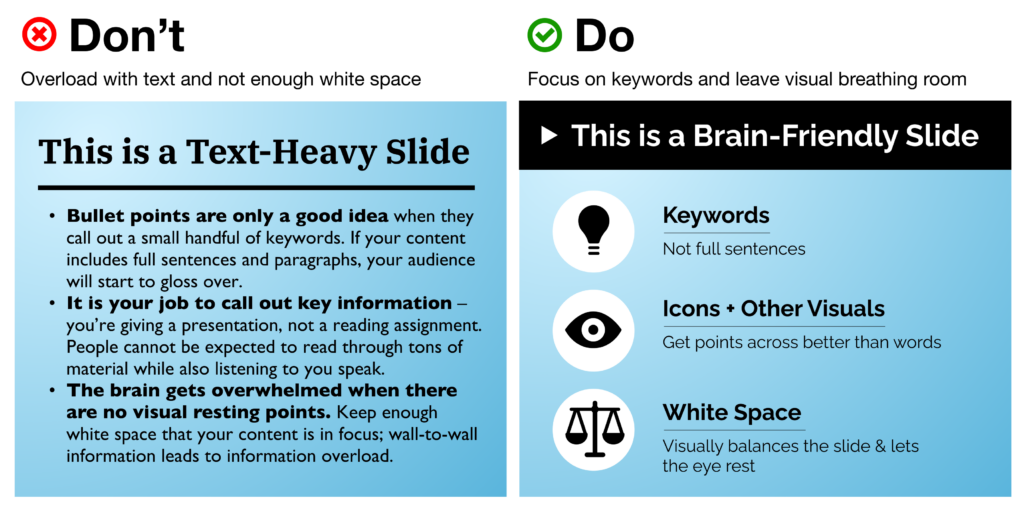Today, I reveal the hard-earned lessons from my own past blunders.
Reader, let's dive in and discover how you can avoid making the same mistakes.
5 DON'TS FOR BEGINNER SPEAKERS
I made these mistakes as a beginner speaker, and I think it might help you to know ...
what not to do before and during your speaking engagement.
Honestly, I have also seen experienced speakers making these mistakes.
1 - Don't Go Unprepared
Speaking anxiety typically comes from 2 sources:
- Core limiting beliefs
- Lack of practice and rehearsal
Today, let's talk about the second source.
Not long ago I hosted a live webinar without any rehearsal.
I said to myself ... "Let's wing it today". Guess what?
It sucked.
I sucked.
I was incoherent, confused, reading slides, and of course NOT confident.
In that moment I realized the importance of practicing and rehearsal.
Dale Carnegie said it quite nicely:
"Only the prepared speaker deserves to be confident".
I surely can attest to that.
Research your topic thoroughly and rehearse it enough times that you can talk about it to anyone.
Prof. Alex Lyon recommends practicing and rehearsing at least 10 times before the event.
Not on a single day
... but spread out over multiple days.
I am guilty of not doing this enough.
I did follow this advice only once when I was scheduled to speak to an audience of 40+ people
... the day when I regained self-confidence and crushed the fear of public speaking.
Even though it was a big occasion, and I was extremely nervous, this one tip alone helped me big time.
It sure will help you too.
So, practice like crazy and don't just wing it.
One caveat—unpopular opinion—is to not practice in front of a mirror.
Think about it Reader ...
Are you going to see your face during the actual speaking engagement?
I don't think so.
In fact, there's a 99.99% chance that you won't see your own face. So, why practice seeing your own face?
Instead, practice it with friends, family, and alone.
Even better ...
record yourself on camera and rewatch it to analyze what gestures to make and what else to improve upon.
2 - Don't Immediately Start Your Talk
Reader, I learned this after delivering numerous talks at Toastmasters Club meetings ...
Don't jump right into your talk after stepping up on stage.
Instead
- Take your time
- Gain awareness
- Breathe
This is what helps me 👇:
I ground myself on stage to a neutral position, where I would spend most of my time during my talk
... typically, at the center of the stage where the audience can easily see me.
Then ...
I take a look at my audience with a smiling face from left to right (or from right to left).
And then, I take a few deep breaths from the belly—also known as diaphragmatic breathing.
These 3 simple steps help me lower the initial spike of nervousness when I step up on stage and set me up for a great public speaking experience.
3 - Don't Look on the Floor/Ceiling or above their heads
When I started out practicing public speaking
... one of the biggest mistakes I used to make was to look away from the audience.
I would look over audiances' heads, on ceiling, and sometimes on the floor just to avoid making direct eye contact with the audience.
This is a huge mistake.
... because when you avoid eye contact with your listener, they have no reason to give you any attention.
Remember ...
the goal of public speaking is to have a conversation with the audience.
With one person at a time.
But when we avoid making eye contact and look away, the connection is broken ...
and the conversation ends right there and then.
The recommended practice is to make eye contact with individual audience members for about 3-5 seconds and then move on to the next person.
What I do is to make eye contact with those members who seem attentive and interested.
Typically, a few on the left side, a few in the center, and a few on the right side
... this way I can cover the entire space.
But if there are very few people in the audience, you can make eye contact with each one of them.
4 - Don't Focus Inwardly, Instead Focus Outwardly
Do you know the difference between self-consciousness and self-confidence?
Reader, we become self-conscious when we constantly worry about what others think or say about us and our flaws.
We don’t want others to find our weaknesses.
Our focus is inward.
We worry that everyone is there to find our flaws and judge us negatively.
Everyone is watching every bit of nervousness that we feel on stage.
In contrast ...
You become self-confident when you accept yourself and don’t care about what others think and say—you embrace your being.
You are no longer afraid to show your weaknesses. You embrace your being and become self-confident.
In other words, your focus is not inward, it's outward.
You focus on your message and the audience.
💡 Self-consciousness is the polar opposite of self-confidence.
5 - Don't Clutter Your Notes/Slides
Most presenters make this mistake all the time.
This DON'T applies to both presentation slides and when using notes during a talk.
Unfortunately, I am also guilty of doing this when preparing technical slides.
We may be tempted to put every bit of information in slides
... or write our speech word-for-word and complete paragraphs in the notes.
Here's why this may be a problem not only for the audience but also for the presenter:
Firstly
... we as a presenter might get lost in the long paragraphs, which is highly likely under high pressure situations.
Secondly
... the audience wouldn't be able to follow the slides and would withdraw from our presentation altogether.
So, what's the point of presenting to them if they are not paying attention?
Instead ...
keep the slides or the notes simple and easy to follow.
Write in bullet points and in BIG visible fonts that are easy to follow.
Make sure figures or illustrations are not too complicated, and easy to understand.
Trust me, we as an audience really appreciate simplicity that requires minimal effort.
Now Reader, which one of these slides do you would be easier to present and easier to look at?
BRINGING IT HOME
TL; DR
- Don't Go Unprepared
- Don't Immediately Start Your Talk
- Don't Look on the Floor/Ceiling or above their heads
- Don't Focus Inwardly, Instead Focus Outwardly
- Don't Clutter Your Notes/Slides
Let me know what you liked about today's issue. Or if there's a question you want me to answer in the next issue.
I personally reply to EVERY email.
THREE MORE WAYS I CAN HELP YOU
1 - Free Discovery Call - Book your free discovery call now to uncover the root of your anxiety and fast-track your journey from nervous to confident speaker 🎤. Don’t miss out—time is of the essence! Seize the opportunity and take that first step toward transformation!
2 - Free live webinar - I will host a Live FREE Webinar on Friday (@1:30 PM MT, 12:30 PM PST, 02:30 PM CST, 03:30 PM EST) in which you will learn three secrets to overcoming your public speaking anxiety.
3 - Social media - I regularly share practical tips and insights on public speaking and communication skills. If you are active on Youtube, Instagram, or Threads, let's connect.
P.S. If you know someone who could benefit from this newsletter, I’d love to have them join our community of public speakers. They can subscribe here. Thanks!
Best,
Waqas, Founder & Speaking Coach
Did you enjoy this week's issue?
|




